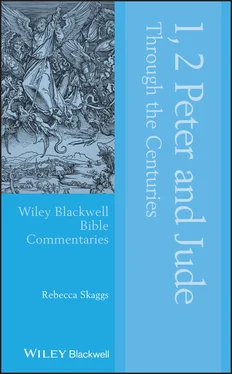Peter uses the metaphor of newborn babies and milk to emphasize the intimacy of the new life. This is different from Paul’s use of the milk metaphor in 1 Corinthians 3:2: whereas Paul contrasts the milk needed by new babies (new converts) with the solid meat craved by adults (mature believers), Peter’s point is that the intense longing for the milk felt by babies expresses the way all believers should feel about their new relation with the Lord – their intense craving for the Lord replaces their life of evil desires (cravings). Two main themes are included here: the life they have left behind and the transformed one they have chosen (elaborated upon with the metaphor of the “living stones”).
The imagery of the metaphors is of interest to the ancient writers. For example, Didymus the Blind comments, “This verse upsets the heretics, who like to think that natures are good or bad in themselves and thereby cannot be changed” ( Comm. on 1 Peter , PG 39: 1761–1762: my tr.). Hilary of Arles allegorizes the milk metaphor in an intriguing way (clearly, he is using one of the medieval exegetical methods. See Lubac, 2000):
Milk has three forms which can be compared to doctrine, that is, the liquid, cheese, and butter. Liquid milk is the literal sense of Scripture, cheese is the moral sense, and butter is the spiritual sense. ( Intro. Comm. on 1 Peter , PLSupp 3: 88, ACC)
Oecumenius stresses still another issue:
These words say a great deal, for it is unworthy of those who have been born again to an incorruptible life to be ensnared by evil and to prefer things which have no existence to that which truly exists. ( Comm. on 1 Peter , PG 119: 529: ccel.org)
Andreas follows Paul in interpreting the milk metaphor; in fact, he paraphrases 1 Corinthians 3:2 ( Catena ). Bede also follows Paul, but goes further to relate the metaphor to the teaching of disciples by the priests: “the priests supply elementary doctrine, which is the rational milk without guile. But they also provide the solid food of more sublime doctrine to those who are more nearly perfect” ( On the Tabernacle and Its Vessels , 2.10.81: TTH 18: 90: ccel.org).
However this metaphor is understood, it had significant impact on church ritual and in fact was involved in the baptismal ceremonial ritual in the early church. Tertullian says it was a sign of new birth, and denoted the communicants’ adoption into God’s family (Tertullian, De cor. Mil . c. 3). St. Jerome connects this to the passage in 1 Peter 2:1–3 about milk (Comment. in Es . LV, 1). Clement of Alexandria also comments on this custom:
As soon as we are born, we are nourished with milk, which is the nutriment of the Lord; and when we are born again, we are honored with the hope of rest by the promise of Jerusalem which is above, where it is said to rain milk and honey: for by these material things we are assured of that sacred food. (Clem. Alex . 1:6, 103: FC)
Included in the third Council of Carthage is the explanation that milk and honey had a unique consecration distinct from that of the Eucharist:
Nothing else should be offered in the sacraments of the body and blood of the Lord but what the Lord commanded, that is, bread and wine mingled with water. But the first‐fruits, and honey and milk, which are offered on one most solemn day for the mystery of infants, though they be offered at the altar, shall have their own peculiar benediction, that they may be distinguished from the sacrament of the body and blood of the Lord. ( Cod. Eccles. Afric . can. 37, ap. Justellun)
Evidently, milk and honey were only to be offered on one special day, that is, on the great Sabbath – the Saturday before Easter, the most solemn time of baptism – and it was only for the mystery of infants, that is, persons newly baptized, who were commonly called infants, in a mystical sense, from their new birth, in the African Church. (See Riddle, 2015: 520; Coleman, 1852: 402; McClintock and Strong Biblical Cyclopedia: archive.org. Bede also relates new birth to baptism, On 1 Peter .)
The Living Stones Metaphor (2:4–10)
Overview
This is the third and final metaphor of this section: even as they personally long for spiritual milk, growth is not individual; rather Peter describes it in terms of community – their transformation “entails incorporation into a new community” (Green, 2007: 61; see also Feldmeier, 2005: 87–88). They will become “living stones” making up a “spiritual house” with access to God himself by means of “spiritual offerings.” This spiritual house is held together by Jesus, the prophesied “chosen and precious cornerstone,” who will also become the “stumbling stone” to those who reject him. The section concludes with the promise that they are now a “chosen people, a royal priesthood, a holy nation, a people belonging to God for the purpose of praising him” (vv.9–10). Whereas they were heretofore strangers and aliens from God, they are now chosen and belong to God, and are incorporated into his community.
The “living stone” imagery interests several ancient writers. For instance, Origen is impressed that “the church is a body and a house of God built upon living stones” ( Comm. on John , 10: 266 OFP: 1762: ccel.org). Augustine explains the metaphor with a somewhat different slant:
The Lord will repay his faithful followers who are so lovingly, so cheerfully, so devotedly carrying out these works, to the effect that he includes them in the construction of his own building, into which they hasten to fit as living stones, fashioned by faith, made solidly firm by hope, cemented together by charity.
( Sermons 337: WSA 3/9: 271)
For Didymus the Blind, the important point is that believers as living stones are built upon the Living Stone [Christ] and the foundation of the apostles and prophets ( Comm. on 1 Peter , PG 39: 1762). Theodoret elaborates on the means by which believers are incorporated into God’s spiritual house: “Those who he calls beforehand are accepted into the church of God … by sharing a common origin … by thinking and saying the same things and sharing the same minds and thoughts, we are built together into one house” ( Catena , CEC: 51: my tr.).
Origen raises a different issue; he is concerned with how those who have died “insufficiently instructed but with a record of acceptable works” might still become “living stones.” He explains that even after death, one can become a living stone:
He [the one who has died without becoming a living stone] will be capable of receiving instruction in that Jerusalem, the city of the saints, i.e., he will be educated and moulded, and made a living stone, a stone elect and precious, because he has undergone with firmness and constancy the struggles of life and the trials of piety; and will there come to a truer and clearer knowledge of that which here has been already predicted. ( On First Principles 2.11.3: ccel.org)
Augustine is also concerned with the state of the unborn, but has a somewhat more negative perspective:
With the exception of the cornerstone which is Christ, I do not see how men are to be built into a house of God, to contain God dwelling in them, without being born again, which cannot happen before they are born the first time. ( Letters 187.31 FC: 30: 246)
For Hilary of Arles, the implication of being built upon such a foundation of Christ and his apostles has serious spiritual ramifications:
You have been built on a good foundation, that of the apostles, prophets and patriarchs … those of you who believe in Christ are more than just stones, you are sons of God! ( Intro. Comm. on 1 Peter , PLSupp 3: 89: ACC)
Читать дальше












